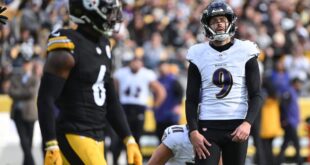The NFL’s 29-3 approval Tuesday of new kickoff rules creates one of the league’s most radical changes ever, with the hope of bringing excitement back to the play while reducing injuries. With it comes intriguing possibilities for strategy and personnel decisions as teams will have to figure it out on the fly this season.
In 2011, the league, looking to cut down on a disproportionate injury risk on kickoffs effectively neutered them by moving the kickoff point from the 30- to 35-yard line, making it much easier for touchbacks to occur. In 2016, the NFL incentivized touchbacks by moving the touchback starting point from the 20 to the 25. The measures reduced injuries by decreasing the number of kicks returned, but the league didn’t address the root cause of the injury.
This offseason, special teams coaches Darren Rizzi (New Orleans Saints), John Fassel (Dallas Cowboys) and Richard Hightower (Chicago Bears) aimed to save kickoffs. They created the hybrid kickoff — an altered version of Sam Schwartzstein’s XFL altered kickoff, which the spring league has used since its restart in 2020. I spoke to Schwartzstein about his altered kickoff and the process of creating and implementing it for the XFL.
The purpose of the new format is to eliminate the running start players had on traditional kickoffs that led to huge collisions, concussions and other injuries. The coverage team and blockers start five yards from each other. Since the alignment and formation are changed, teams can no longer surprise onside kick. Teams can still onside kick if they are trailing in the fourth quarter and declare they intend to. Onside kicks will also be played out with the new set up and landing zones.
To address the lowest kickoff return rate in @NFL history during the 2023 season and concern for player health and safety, the NFL Competition Committee has proposed a new kickoff rule.
If adopted by NFL clubs, the new rule will keep the excitement of kickoff returns in the… pic.twitter.com/0ltQpSrAvC
— NFL Football Operations (@NFLFootballOps) March 22, 2024
The past changes to kickoffs resulted in onside kicks rarely recovered. Last season, only two surprise onside kicks were attempted and neither was successful.
Understanding the basics
NFL’s hybrid kickoff basic rules
Zone rules:
• The ball has to be returned if it’s kicked into the landing zone.
• If the ball is kicked short of the landing zone or out of bounds, it will be placed on the 40-yard line.
• The ball can still be returned if it rolls to the end zone or kicked to the end zone through the air.
• If the ball is kicked into the landing zone, rolls into the end zone and gets downed by the kickoff team, it will placed at the 20-yard line.
• If the ball is kicked through the air to the end zone and gets downed, it will be placed at the 30-yard line.
(Drew Jordan / The Athletic)
Procedural:
• Every member of the coverage team (kicking team) aside from the kicker has to have one foot on the 40-yard line.
• The coverage team cannot move until the ball is touched by the return team or hits the ground in the landing zone.
• The return team can have nine to 10 players blocking in the set up zone depending on whether it has one or two returners (maximum two returners).
• The return team must have at least seven players on the 35-yard line (it can have two or three players off the line but in the set up zone).
• The return team cannot move until the ball is touched or hits the ground (presumably a referee will signal when they can move since their backs will be turned to the landing zone).
How these rules will be enforced and penalized is not clear yet and is still likely being discussed.
The full set of rules can be found here.
Schwartzstein and his team with the XFL didn’t know what to expect with their format. Would there be touchdowns on every kick? Would the coverage team swarm the ball too quickly? Of course, they had their theories but no one could know for sure, so they tested it in minor leagues and with junior colleges for two years before implementing it with the XFL. They went to schools like Pearl River and Mississippi Gulf Coast and essentially paid them to experiment. They led meetings with coaching staffs and players, came back a month later, did practices and then tested their rules in controlled scrimmages. As far as we know, the NFL has not tested its version and although it’s very similar to the XFL’s, the slight differences could have an impact.
The main differences from the XFL’s kickoff:
• The XFL only allows one returner because it didn’t want the second returner to become a lead blocker and build up speed, increasing the chance for a high-impact collision.
• If the ball lands on the ground in the landing zone, XFL players in the set up zone can’t move until it’s picked up or the ball is on the ground for more than three seconds.
• The XFL kicked off from the 30-yard line rather than the 35-yard line to make it harder for touchbacks.
Schwartzstein and his team used the data from their tests to adjust their rules and format into the final product they unveiled when the XFL debuted. It’ll be interesting to see what results the NFL’s tweaks will garner. For example, on one of Schwartzstein’s first tests, the ball hit the ground in the landing zone and because no one in the set up zone could move until the returner touched the ball, the returner took his time before picking up the ball. This gave the play an awkward pause Schwartzstein didn’t want, hence the three-second timer from when the ball hits the ground.

GO DEEPER
NFL bans ‘hip-drop tackle’ at league owners’ meetings
The NFL will allow players to move as soon as the ball hits the ground. While this will eliminate the pausing problem, it could encourage more ground balls and allow the coverage team to get to the returner too quickly. Without testing, some of the NFL’s tweaks might have unintended results. They’ll likely test in spring practices, training camp and preseason, but it might be too late to tweak the rules by then.
This hybrid kickoff is like unlocking a new mini-game within football. The first teams to figure out how to strategize and get creative with covering and returning will have a massive advantage this season. The proximity of the coverage team and blockers completely changes the kickoff strategy. The schemes will be more reminiscent of offensive line blocking schemes. Double-teams and wedge blocking, which were previously restricted for return units, will be allowed. But the second returner, who would become a lead blocker, cannot be part of double-teams.
One strategy will be resetting the line of scrimmage, which means the blockers will attack the coverage team to make contact sooner rather than wait for them. Some XFL teams used pin-and-pull schemes in which blockers pin defenders inside while other blockers pull around them.
On this clip from the XFL, the return team left the third player from the sideline on the coverage team unblocked so he could get trapped by an outside player. The idea is similar to a trap play offenses run. Some other run-blocking schemes and principles should translate to kick returns. Offensive line coaches could be useful resources for special teams coordinators as they draw up plays.
Here, is a creative reverse in which a player from the set up zone looped around to get the ball. Since there is no baseline of ideas and concepts for hybrid kickoffs, plays will be experimental. Coaches have to figure out best practices on the fly and be willing to be creative.
How teams implement personnel also will be interesting. Rather than having traditional return specialists, who are usually better open-field runners, teams may want to use running backs, who have great vision and can anticipate a lane opening and hit it at full speed. The returner only needs to get past one level, so open-field elusiveness may not be as important. Maybe teams will use their star running backs as returners in big games. Saquon Barkley could be terrifying as a returner for the Philadelphia Eagles. The San Francisco 49ers could have Deebo Samuel and Christian McCaffrey both back as returners. Who will teams use as blockers? Will return units be made up of tight ends and maybe a few very athletic offensive linemen? Will coverage teams use defensive linemen, who can quickly shed blocks?
The possibilities are endless. Because of the safety measures, teams should be willing to use more starters on these units, especially, if there’s an increased chance of better field position or touchdowns. With the best special teams coordinators and incredible athletes, the hybrid kickoff has the potential to be spectacular. But because there aren’t established baseline strategies, there is also potential for a big gap in parity. Teams that can’t figure things out can get left behind quickly. Those teams may have to attempt touchbacks and give opponents the ball at the 30-yard line. Figuring out strategies for the hybrid kickoff will be like an arms race in this coming season.
(Top photo: John McCoy and Tom Hauck / Getty Images)
 meganwoolsey Home
meganwoolsey Home




